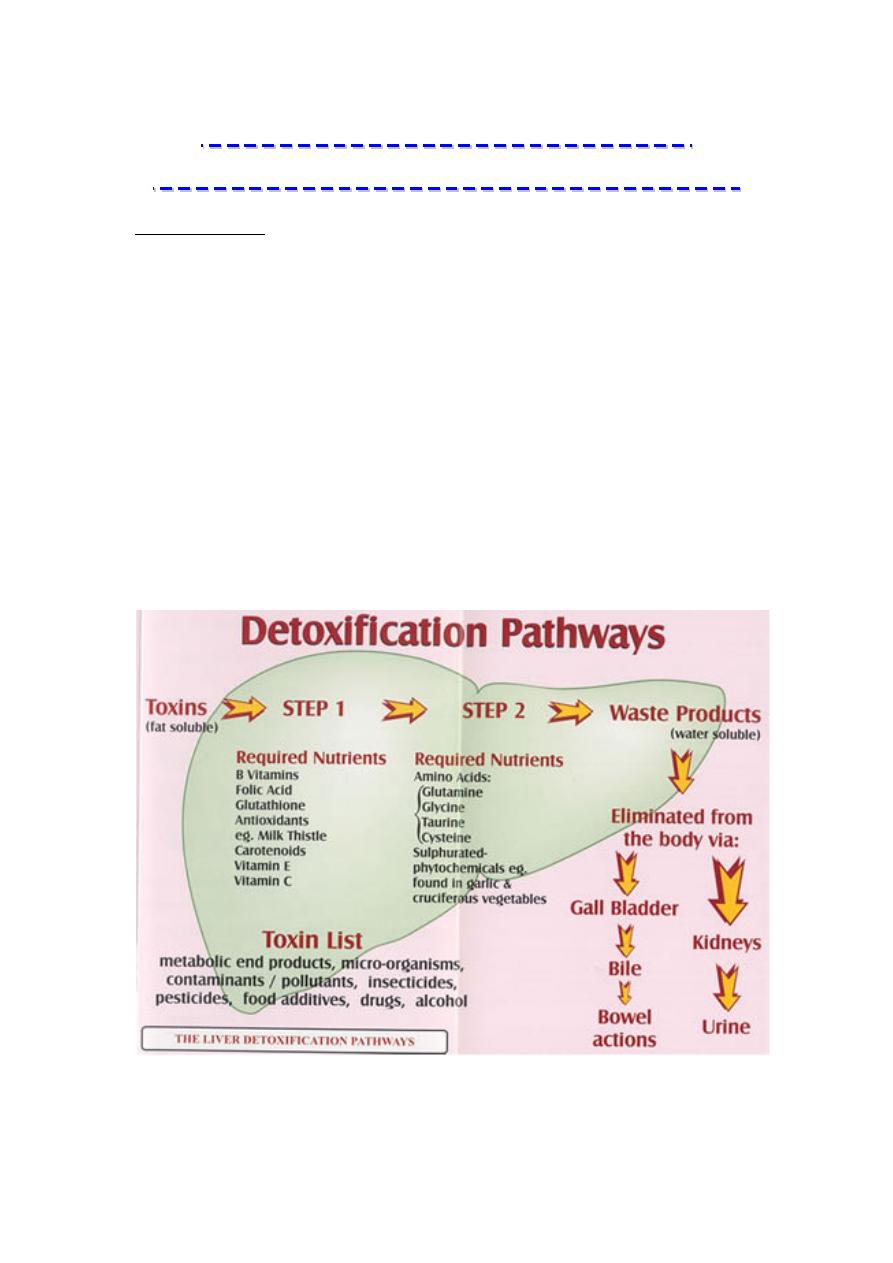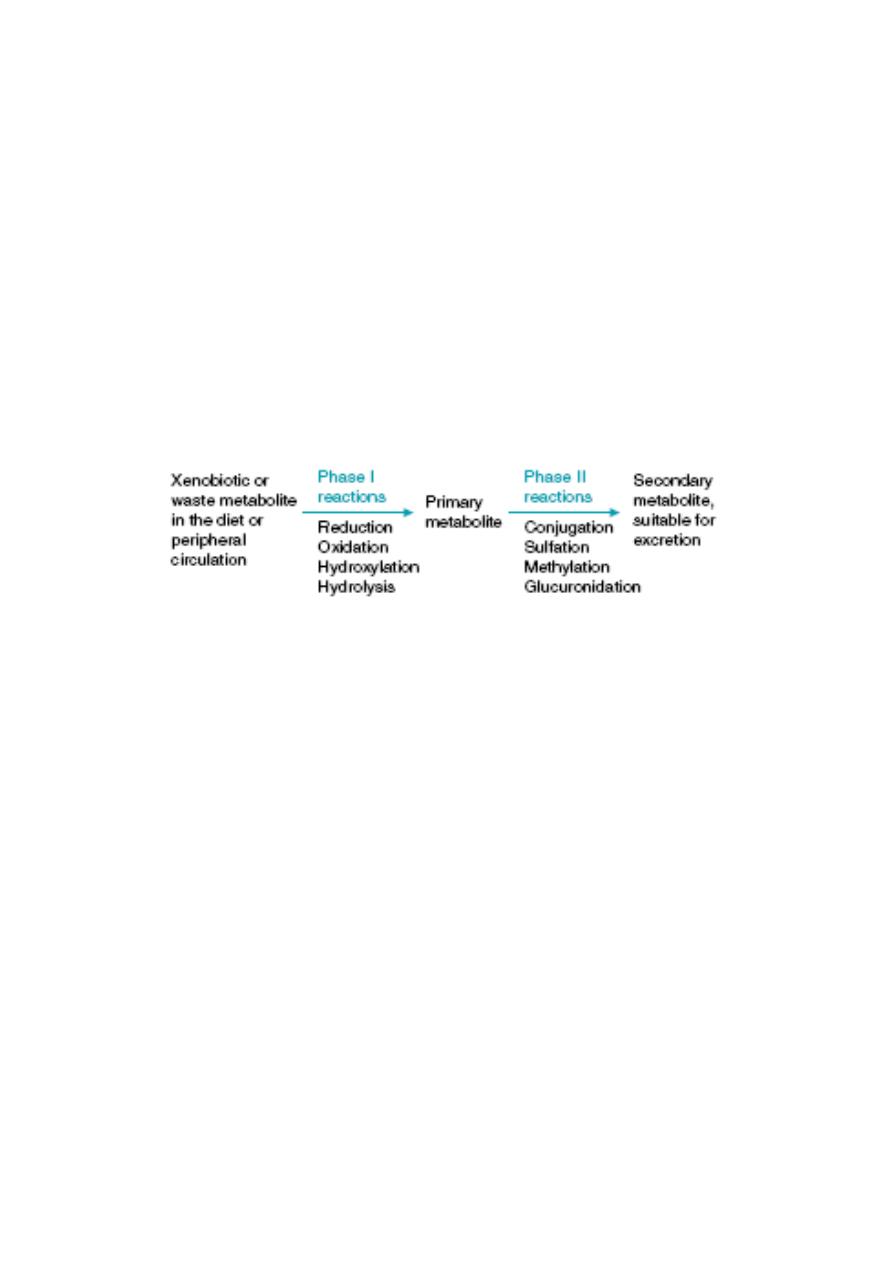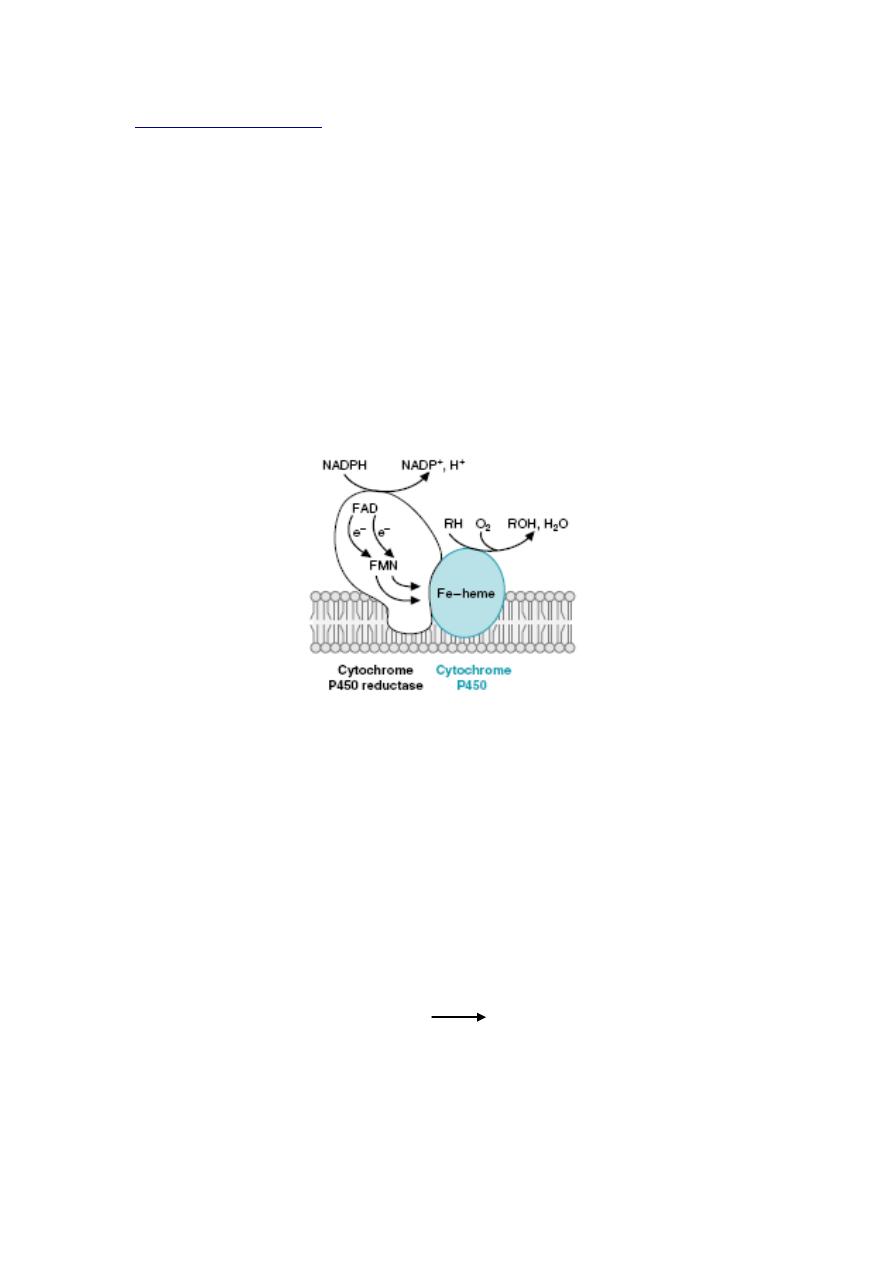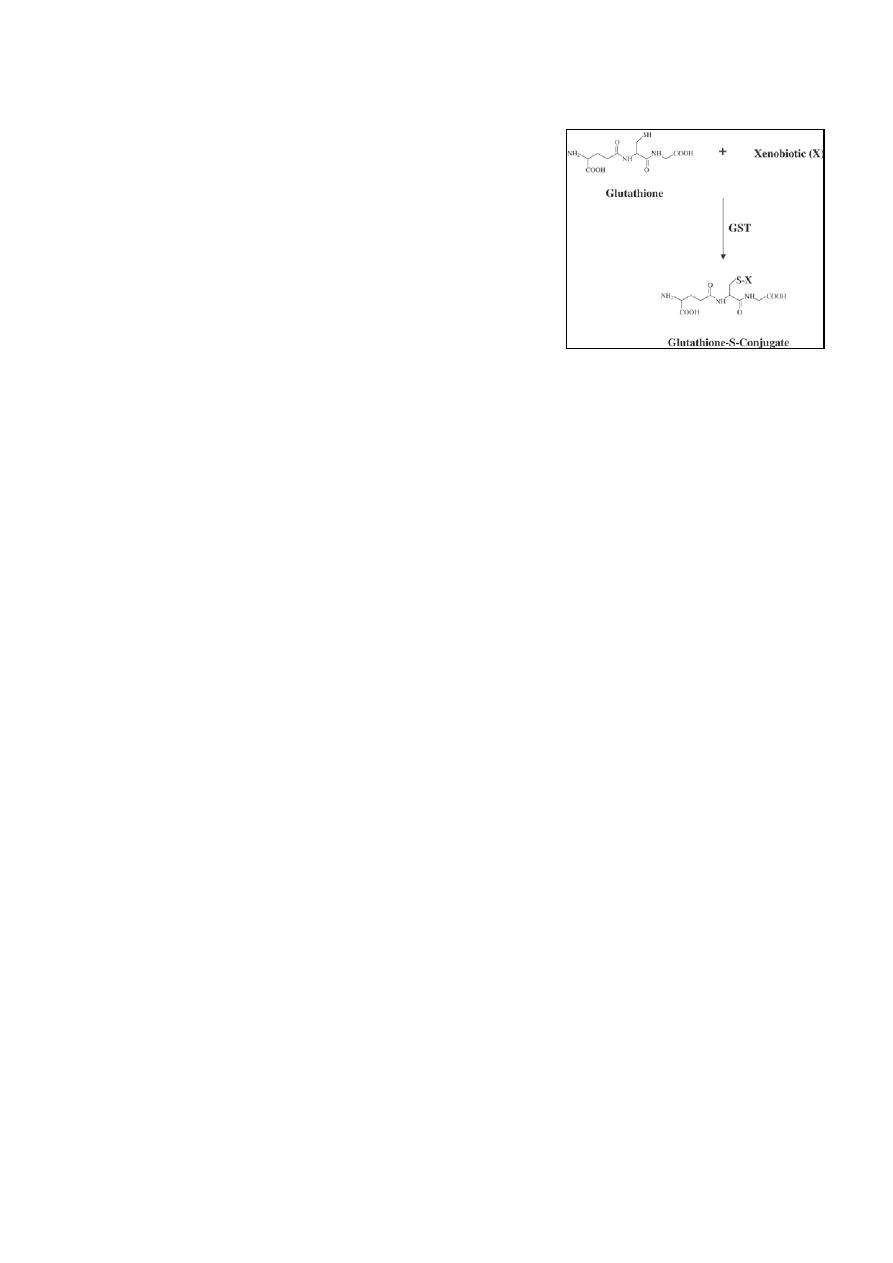
Lecture 7
Sunday 3/10/2013
Prof. Dr.H.D.El-Yasin
1
I
I
n
n
a
a
c
c
t
t
i
i
v
v
a
a
t
t
i
i
o
o
n
n
a
a
n
n
d
d
D
D
e
e
t
t
o
o
x
x
i
i
f
f
i
i
c
c
a
a
t
t
i
i
o
o
n
n
o
o
f
f
X
X
e
e
n
n
o
o
b
b
i
i
o
o
t
t
i
i
c
c
s
s
a
a
n
n
d
d
M
M
e
e
t
t
a
a
b
b
o
o
l
l
i
i
t
t
e
e
s
s
i
i
n
n
t
t
h
h
e
e
L
L
i
i
v
v
e
e
r
r
Aim of lecture 7:
1. to describe detoxification pathways and phases in the liver,
The liver is one of the most important organs in the body when it comes to
detoxifying or getting rid of foreign substances or toxins, especially from the
gut.
The liver detoxifies harmful substances by a complex series of chemical
reactions. The role of these various enzyme activities in the liver is to convert
fat soluble toxins into water soluble substances that can be excreted in the
urine or the bile depending on the particular characteristics of the end product.
Many of the toxic chemicals that enter the body are fat-soluble, which means
they dissolve only in fatty or oily solutions and not in water. This makes them
difficult for the body to excrete. Fat soluble chemicals have a high affinity for
fat tissues and cell membranes, which are composed of fatty acids and
proteins. In these fatty tissues of the body, toxins may be stored for years,
being released during times of exercise, stress or fasting.
The liver plays several roles in detoxification: it filters the blood to remove
large toxins, synthesizes and secretes bile full of cholesterol and other fat-
soluble toxins, and enzymatically disassembles unwanted chemicals.

Lecture 7
Sunday 3/10/2013
Prof. Dr.H.D.El-Yasin
2
The enzymatic process usually occurs in two steps referred to as: phase I
and phase II.
Xenobiotics are compounds that have no nutrient value (cannot be
used by the body for energy requirements) and are potentially toxic. They are
present as natural components of foods or they may be introduced into foods
as additives or through processing. Pharmacologic and recreational drugs are
also xenobiotic compounds. The liver is the principal site in the body for the
degradation of these compounds. Because many of these substances are
lipophilic, they are oxidized, hydroxylated, or hydrolyzed by enzymes in phase
I reactions. Phase I reactions introduce or expose hydroxyl groups or other
reactive sites that can be used for conjugation reactions (the phase II
reactions).
The conjugation reactions add a negatively charged group such as glycine or
sulfate to the molecule. Many xenobiotic compounds will be transformed
through several different pathways.
Phase I either directly neutralizes a toxin, or modifies the toxic chemical to
form activated intermediates which are then neutralized by one of more of the
several phase II enzyme systems.
The conjugation and inactivation pathways are similar to those used by the
liver to inactivate many of its own metabolic waste products. These pathways
are intimately related to the biosynthetic cascades that exist in the liver. The
liver can synthesize the precursors that are required for conjugation and
inactivation reactions from other compounds. For example, sulfation is used
by the liver to clear steroid hormones from the circulation. The sulfate used for
this purpose can be obtained from the degradation of cysteine or methionine.
The liver, kidney, and intestine are the major sites in the body for
biotransformation of xenobiotic compounds. Many xenobiotic compounds
contain aromatic rings (such as benzopyrene in tobacco smoke) or
heterocyclic ring structures (such as the nitrogen-containing rings of nicotine
or pyridoxine) that we are unable to degrade or recycle into useful
components. These structures are hydrophobic, causing the molecules to be
retained in adipose tissue unless they are sequestered by the liver, kidney, or
intestine for biotransformation reactions. Sometimes, however, the phase I
and II reactions backfire, and harmless hydrophobic molecules are converted
to toxins or potent chemical carcinogens.
The level of exposure to environmental carcinogens varies widely, as does
the efficiency of the detoxification enzymes, particularly phase II. High levels
of exposure to carcinogens coupled with slow detoxification enzymes
significantly increases susceptibility to cancer.

Lecture 7
Sunday 3/10/2013
Prof. Dr.H.D.El-Yasin
3
Phase I Detoxification
CYTOCHROME P450 AND XENOBIOTIC METABOLISM
The cytochrome P450 enzyme family contains at least 100 to 150 different
isozymes. The human enzymes are generally divided into six major
subfamilies, and each of these is further subdivided. For example, in the
naming of the principal enzyme involved in the oxidation of ethanol to
acetaldehyde, CYP2E1, the CYP denotes the cytochrome P450 family, the 2
denotes the subfamily, the E denotes ethanol, and the 1 denotes the specific
isozyme.
The cytochrome P450–dependent monooxygenase enzymes are
determinants in oxidative, peroxidative, and reductive degradation of
exogenous (chemicals, carcinogens, and pollutants, etc.) and endogenous
(steroids, prostaglandins retinoids, etc.) substances. The key enzymatic
constituents of this system are the flavo-protein NADPH-cytochrome P450
oxidoreductase and cytochrome P450.
General structure of the P450 enzymes. O
2
binds to the P450 Fe-heme in
the active site and is activated to a reactive form by accepting electrons.
The electrons are donated by the cytochrome P450 reductase, which
contains an FAD plus an FMN or Fe-S center to facilitate the transfer of
single electrons from NADPH to O2. The P450 enzymes involved in
steroidogenesis have a somewhat different structure. For CYP2E1, RH is
ethanol (CH3CH2OH), and ROH is acetaldehyde (CH3COH).
Monooxygenase incorporate one atom from molecular oxygen into a substrate
(creating a hydroxyl group), with the other atom being reduced to water. In the
cytochrome P450 monooxygenase system NADPH provides the reducing
equivalents required by the series of reactions. This system performs different
functions in two separate locations in cells.The overall reaction catalyzed by a
cytochrome P450 enzyme is:
R-H + O
2
+ NADPH + H
+
R-OH + H
2
O + NADP
+
where R may be a steroid, drug or other chemical.

Lecture 7
Sunday 3/10/2013
Prof. Dr.H.D.El-Yasin
4
The cytochrome P450 isozymes all have certain features in common:
1. They all contain cytochrome P450, oxidize the substrate, and reduce
oxygen.
2. They all have a flavin-containing reductase subunit that uses NADPH,
and not NADH, as a substrate.
3. They are all found in the smooth endoplasmic reticulum and are
referred to as microsomal enzymes (for example, CYP2E1 is also
referred to as the microsomal ethanol oxidizing system, MEOS).
4. They are all bound to the lipid portion of the membrane, probably to
phosphatidylcholine.
5. They are all inducible by the presence of their own best substrate and
somewhat less inducible by the substrates for other P450 isozymes.
6. They all generate a reactive free radical compound as an intermediate
in the reaction.
Excessive amounts of toxic chemicals such as pesticides can disrupt the P-
450 enzyme system by causing hyper activity or what is called 'induction' of
this pathway. This will result in high levels of damaging free radicals being
produced. Substances that may cause hyperactivity of the P- 450 enzymes:
Caffeine, Alcohol, Dioxin, Saturated fats, Organophosphorus pesticides, Paint
fumes, Sulfonamides, Exhaust fumes, Barbiturates.
Transforming a toxin to a more chemically reactive form makes it more easily
metabolized by the phase II enzymes.
If the phase II detoxification systems are not working adequately, these
intermediates can cause substantial damage, including the initiation of
carcinogenic processes. Each enzyme works best in detoxifying certain types
of chemicals, but with considerable overlap in activity among the enzymes.
The activity of the various cytochrome P450 enzymes varies significantly from
one individual to another, based on genetics, the individual's level of exposure
to chemical toxins, and his or her nutritional status. Since the activity of
cytochrome P450 varies so much, so does an individual's risk for various
diseases. This variability of cytochrome P450 enzymes is seen in the
variability of people's ability to detoxify the carcinogens found in cigarette
smoke and helps to explain why some people can smoke with only modest
damage to their lungs, while others develop lung cancer after only a few
decades of smoking.
A significant side-effect of phase I detoxification is the production of free
radicals as the toxins are transformed--for each molecule of toxin metabolized
by phase I, one molecule of free radical is generated. Without adequate free
radical defenses, every time the liver neutralizes a toxin exposure, it is
damaged by the free radicals produced.
The most important antioxidant for neutralizing the free radicals produced in
phase I is glutathione. In the process of neutralizing free radicals, however,
glutathione (GSH) is oxidized to glutathione disulfide (GSSG). Glutathione is
required for one of the key phase II detoxification processes. When high
levels of toxin exposure produce so many free radicals from phase I

Lecture 7
Sunday 3/10/2013
Prof. Dr.H.D.El-Yasin
5
detoxification that the glutathione is depleted, the phase II processes
dependent upon glutathione stop, producing oxidative stress or liver damage.
The toxins transformed into activated intermediates by phase I are
substantially more reactive than the phase I toxins were. Unless quickly
removed from the body by phase II detoxification mechanisms, they can
cause widespread problems, especially carcinogenesis. Therefore, the rate at
which phase I produces activated intermediates must be balanced by the rate
at which phase II finishes their processing. People with a very active phase I
detoxification system coupled with slow or inactive phase II enzymes are
termed pathological detoxifiers. These people suffer unusually severe toxic
reactions to environmental poisons.
An efficient liver detoxification system is vital to health and in order to support
this process it is essential that many key nutrients are included in the diet.
Vitamins and minerals – particularly the B vitamins – play a major role, acting
as cofactors for many enzyme systems including those of liver detoxification.
Depletion of vitamin C may also impair the detoxification process; vitamin C
also prevents free radical formation. Vitamin E and selenium are cofactors for
glutathione peroxidase activity as well as being powerful antioxidants. Other
nutrients which play vital roles in the Phase II pathway include amino acids
glycine, cysteine, glutamine, methionine, taurine, glutamic acid and aspartic
acid.
As with all enzymes, the cytochrome P450s require several nutrients to
function, such as copper, magnesium, zinc and vitamin C.
Phase II Detoxification
This is called the conjugation pathway, whereby the liver cells add another
substance (eg. cysteine, glycine or a sulphur molecule) to a toxic chemical or
drug. This makes the toxin or drug water-soluble, so it can then be excreted
from the body via watery fluids such as bile or urine. Individual xenobiotics
and metabolites usually follow one or two distinct pathways.
Pop quiz: Which of the following mechanisms play a prominent role in phase II
detoxification?
a. Conjugation
b. Oxidation
c. Hydrolysis
d. Reduction
There are essentially six phase II detoxification pathways:
1. Glutathione conjugation
2. Amino acid conjugation
3. Methylation
4. Sulfation
5. Acetylation
6. Glucuronidation

Lecture 7
Sunday 3/10/2013
Prof. Dr.H.D.El-Yasin
6
1. Glutathione conjugation
A primary phase II detoxification route is conjugation
with glutathione
(γ-glutamylcysteinylglycine), (a
tripeptide composed of three amino acids--cysteine,
glutamic acid, and glycine).
Glutathione conjugation produces water-soluble
mercaptates which are excreted via the kidneys.
The elimination of fat-soluble compounds, especially
heavy metals like mercury and lead, is dependent
upon adequate levels of glutathione, which in turn is
dependent upon adequate levels of methionine and
cysteine. When increased levels of toxic
compounds are present, more methionine is utilized for cysteine and
glutathione synthesis. Methionine and cysteine have a protective effect on
glutathione and prevent depletion during toxic overload. This, in turn, protects
the liver from the damaging effects of toxic compounds and promotes their
elimination.
If the availability of methionine is reduced, not only will the capability of the
liver to detoxify be impaired, but there will also be less glutathione available to
complex with foreign substances.
Studies have demonstrated that a deficiency of methionine can, in itself,
cause liver cancer without the presence of a carcinogen, and also that the
deficiency of methionine can permit a heavy metal to cause toxic effects.
Glutathione is also an important antioxidant. This combination of detoxification
and free radical protection, results in glutathione being one of the most
important anticarcinogens and antioxidants in our cells, which means that a
deficiency is cause of serious liver dysfunction and damage. Exposure to high
levels of toxins depletes glutathione faster than it can be produced or
absorbed from the diet. This results in increased susceptibility to toxin-
induced diseases, such as cancer, especially if phase I detoxification system
is highly active.
A deficiency can be induced either by diseases that increase the need for
glutathione, deficiencies of the nutrients needed for synthesis, or diseases
that inhibit its formation. Glutathione is available through two routes: diet and
synthesis. Dietary glutathione (found in fresh fruits and vegetables, cooked
fish, and meat) is absorbed well by the intestines and does not appear to be
affected by the digestive processes. Dietary glutathione in foods appears to
be efficiently absorbed into the blood.
2. Amino acid conjugation
Several amino acids (glyucine, taurine, glutamine, arginine, and ornithine) are
used to combine with and neutralize toxins. Of these, glycine is the most
commonly utilized in phase II amino acid detoxification.
Patients suffering from hepatitis, alcoholic liver disorders, carcinomas, chronic
arthritis, hypothyroidism, toxemia of pregnancy, and excessive chemical
exposure are commonly found to have a poorly functioning amino acid
conjugation system.

Lecture 7
Sunday 3/10/2013
Prof. Dr.H.D.El-Yasin
7
Even in normal adults, a wide variation exists in the activity of the glycine
conjugation pathway. This is due not only to genetic variation, but also to the
availability of glycine in the liver. Glycine, and the other amino acids used for
conjugation, become deficient on a low-protein diet and when chronic
exposure to toxins results in depletion.
3. Methylation
Methylation involves conjugating methyl groups to toxins.
Most of the methyl groups used for detoxification comes from S-
adenosylmethionine (SAM). SAM is synthesized from the amino acid
methionine, a process which requires the nutrients choline, the active form of
B
12
--methyl cobalamin, and the active form of folic acid --5-
methyltetrahydrofolate. Methionine is a major source of numerous sulfur-
containing compounds, including the amino acids cysteine and taurine.
4. Sulfation
Sulfation is the conjugation of toxins with sulfur-containing compounds. The
sulfation system is important for detoxifying several drugs, food additives,
and, especially, toxins from intestinal bacteria and the environment. In
addition to environmental toxins, sulfation is also used to detoxify some
normal body chemicals and is the main pathway for the elimination of steroid
and thyroid hormones. Since sulfation is also the primary route for the
elimination of neurotransmitters, dysfunction in this system may contribute to
the development of some nervous system disorders.
Many factors influence the activity of sulfate conjugation. For example, a diet
low in methionine and cysteine has been shown to reduce sulfation.
5. Acetylation
Conjugation of toxins with acetyl-CoA is the primary method by which the
body eliminates sulfa drugs. This system appears to be especially sensitive to
genetic variation, with those having a poor acetylation system being far more
susceptible to sulfa drugs and other antibiotics. While not much is known
about how to directly improve the activity of this system, it is known that
acetylation is dependent on thiamine, pantothenic acid, and vitamin C.
6. Glucuronidation
Glucuronidation, the combining of glucuronic acid with toxins, in Phase II can
be reversed by Beta glucuronidase enzymes produced by pathological
bacteria and cause toxins to be reabsorbed increasing toxicity. Many of the
commonly prescribed drugs are detoxified through this pathway. It also helps
to detoxify aspirin, menthol, vanillin (synthetic vanilla), food additives such as
benzoates, and some hormones.
Sulfoxidation
Sulfoxidation is the process by which the sulfur-containing molecules in drugs
and foods are metabolized. It is also the process by which the body eliminates
the sulfite food additives used to preserve many foods and drugs. Normally,
the enzyme sulfite oxidase (molybdenum dependentenzyme) metabolizes
sulfites to safer sulfates, which are then excreted in the urine. Those with a
poorly functioning sulfoxidation system, however, have an increased ratio of

Lecture 7
Sunday 3/10/2013
Prof. Dr.H.D.El-Yasin
8
sulfite to sulfate in their urine. Those with a poorly functioning sulfoxidation
detoxification pathway are more sensitive to sulfur-containing drugs and foods
containing sulfur or sulfite additives.
Conclusions:
The liver plays several roles in detoxification: it filters the blood to remove
large toxins, synthesizes and secretes bile full of cholesterol and other fat-
soluble toxins, and enzymatically disassembles unwanted chemicals.
The enzymatic process usually occurs in two steps referred to as: phase I
and phase II.
